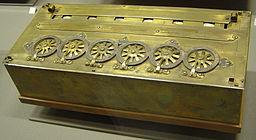
Blaise Pascal’s ‘Pascaline’. 1652. (Musée des Arts et Métiers, Paris; source of image: Wikimedia Commons)
The latest calendar to be added to the growing set of mathematical correspondences in EMLO is centred around the letters of a prodigy. Blaise Pascal was introduced to Mersenne’s circle of Parisian savants when only in his mid-teens, at which point he was furthering significantly Girard Desargues’s work on conic sections. Educated by his father Etienne Pascal, himself a lawyer and amateur mathematician of exceptional talent, this young lad invented a calculating machine — the Pascaline — primarily to assist his father with tax calculations. He progressed to work on what became known as Pascal’s triangle, and and focused also on questions relating to the pressure of air, attempting to replicate Evangelista Torricelli’s experiments, as a result of which found himself in opposition to Descartes, Pascal’s life was altered irrevocably in 1646 following an accident on ice that left his father with a broken leg. The temporary installment of two bonesetters, the Deschamp brothers, within the Pascal family home in Rouen set in motion the family’s involvement with the Jansenist movement and resulted in one of Blaise’s siblings, Jacqueline, joining the Abbaye de Port-Royal des Champs. From 1654, three years after his father’s death, Pascal turned his attention to religion. Les Lettres provinciales were written and published in defence of Antoine Arnauld, an opponent of the Jesuits and a defender of Jansenism. Upon Blaise Pascal’s death in 1662, the philosophical work for which he became best known remained unfinished and was published subsequently as Pensées.
This calendar of correspondence, based on metadata from an edition of letters that was published in 1922, lists letters that span Pascal’s adult life from 1943 until shortly before his death. Each letter record in EMLO provides a link to the printed copy and we hope very much you set aside your summer-beach reading and dip into the world of Pascal. Should you find yourself with time to explore further, you might be interested to know that our developer, Mat Wilcoxson, has been working to refine how we search and retrieve thematic clusters of correspondences in the union catalogue and, as proof of concept, I’m thrilled to be able to demonstrate that we are able now to summon up together all the calendars of correspondence of the mathematicians listed currently in EMLO. Quite the formula for beach combing indeed!
